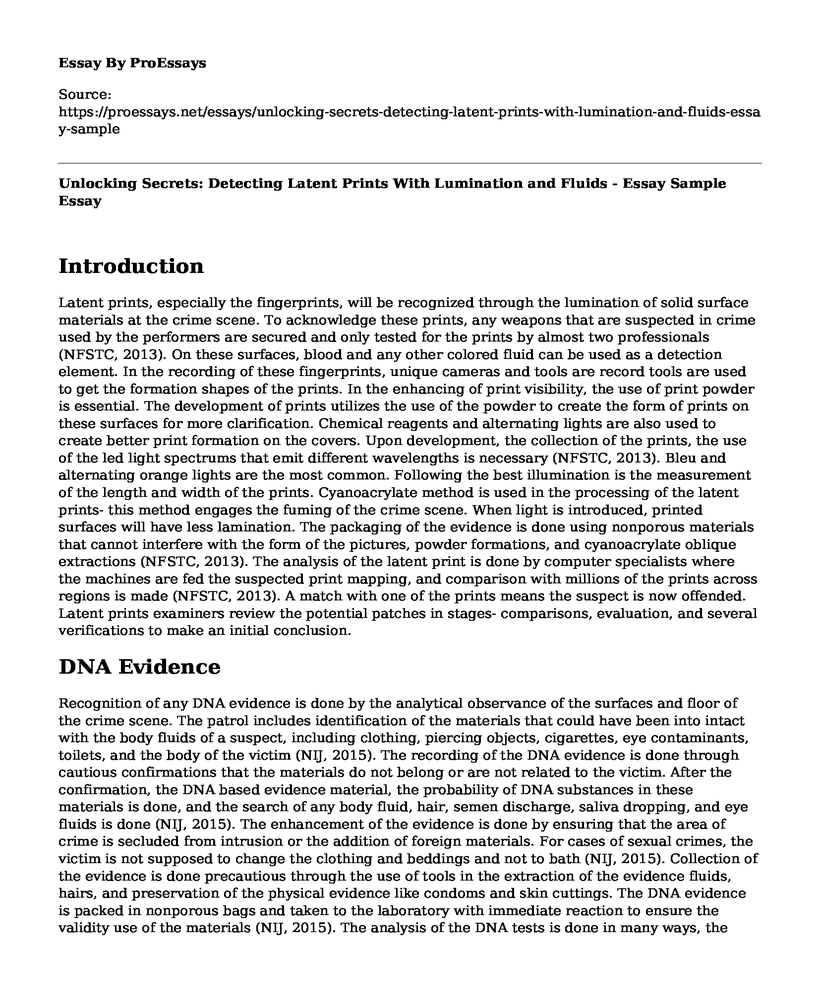Introduction
Latent prints, especially the fingerprints, will be recognized through the lumination of solid surface materials at the crime scene. To acknowledge these prints, any weapons that are suspected in crime used by the performers are secured and only tested for the prints by almost two professionals (NFSTC, 2013). On these surfaces, blood and any other colored fluid can be used as a detection element. In the recording of these fingerprints, unique cameras and tools are record tools are used to get the formation shapes of the prints. In the enhancing of print visibility, the use of print powder is essential. The development of prints utilizes the use of the powder to create the form of prints on these surfaces for more clarification. Chemical reagents and alternating lights are also used to create better print formation on the covers. Upon development, the collection of the prints, the use of the led light spectrums that emit different wavelengths is necessary (NFSTC, 2013). Bleu and alternating orange lights are the most common. Following the best illumination is the measurement of the length and width of the prints. Cyanoacrylate method is used in the processing of the latent prints- this method engages the fuming of the crime scene. When light is introduced, printed surfaces will have less lamination. The packaging of the evidence is done using nonporous materials that cannot interfere with the form of the pictures, powder formations, and cyanoacrylate oblique extractions (NFSTC, 2013). The analysis of the latent print is done by computer specialists where the machines are fed the suspected print mapping, and comparison with millions of the prints across regions is made (NFSTC, 2013). A match with one of the prints means the suspect is now offended. Latent prints examiners review the potential patches in stages- comparisons, evaluation, and several verifications to make an initial conclusion.DNA Evidence
Recognition of any DNA evidence is done by the analytical observance of the surfaces and floor of the crime scene. The patrol includes identification of the materials that could have been into intact with the body fluids of a suspect, including clothing, piercing objects, cigarettes, eye contaminants, toilets, and the body of the victim (NIJ, 2015). The recording of the DNA evidence is done through cautious confirmations that the materials do not belong or are not related to the victim. After the confirmation, the DNA based evidence material, the probability of DNA substances in these materials is done, and the search of any body fluid, hair, semen discharge, saliva dropping, and eye fluids is done (NIJ, 2015). The enhancement of the evidence is done by ensuring that the area of crime is secluded from intrusion or the addition of foreign materials. For cases of sexual crimes, the victim is not supposed to change the clothing and beddings and not to bath (NIJ, 2015). Collection of the evidence is done precautious through the use of tools in the extraction of the evidence fluids, hairs, and preservation of the physical evidence like condoms and skin cuttings. The DNA evidence is packed in nonporous bags and taken to the laboratory with immediate reaction to ensure the validity use of the materials (NIJ, 2015). The analysis of the DNA tests is done in many ways, the best being biological polymerase that involves a chain of reactions. Million copies f the DNA profiles are made, and the most abundant collected to be the initial DNA for the evidence material (NIJ, 2015). The inclusion and exclusion methods are used n matching the results with suspects' DNA structures. The inclusion method involves the similarity matching exclusion method include difference analysis.
References
NFSTC. (2013). A Simplified Guide to Fingerprint Analysis. Retrieved from http://www.forensicsciencesimplified.org/prints/how.html
NIJ. (2015). DNA Evidence: Basics of Analyzing. Retrieved from https://nij.ojp.gov/topics/articles/dna-evidence-basics-analyzing
Cite this page
Unlocking Secrets: Detecting Latent Prints With Lumination and Fluids - Essay Sample. (2023, Jun 09). Retrieved from https://proessays.net/essays/unlocking-secrets-detecting-latent-prints-with-lumination-and-fluids-essay-sample
If you are the original author of this essay and no longer wish to have it published on the ProEssays website, please click below to request its removal:
- Expository Essay on Identity Theft in the Information Age
- Essay on Witnessing a Real Court Hearing in King County Superior Court
- Reparations for Human Rights Violations: Benefits & Guidelines - Essay Sample
- Recidivism: Prior Conviction, Reoffending, and Delinquent Action - Essay Sample
- Essay Sample on Civil & Criminal Cases: Comparing Procedures
- Lesser Included Offenses: Court Judgment & Reasons for Conviction - Essay Sample
- Saudi Arabia's Modernizing Criminal Justice & Political System - Essay Sample







